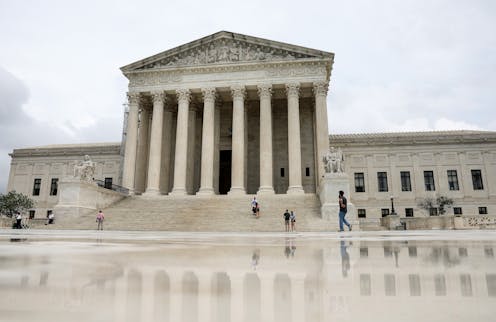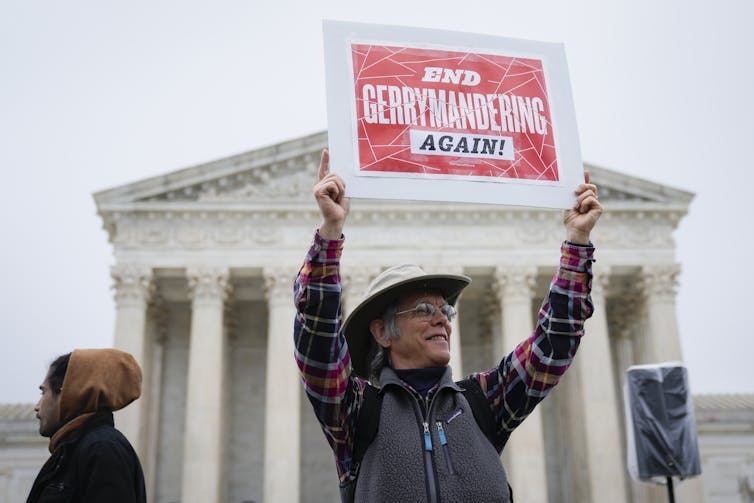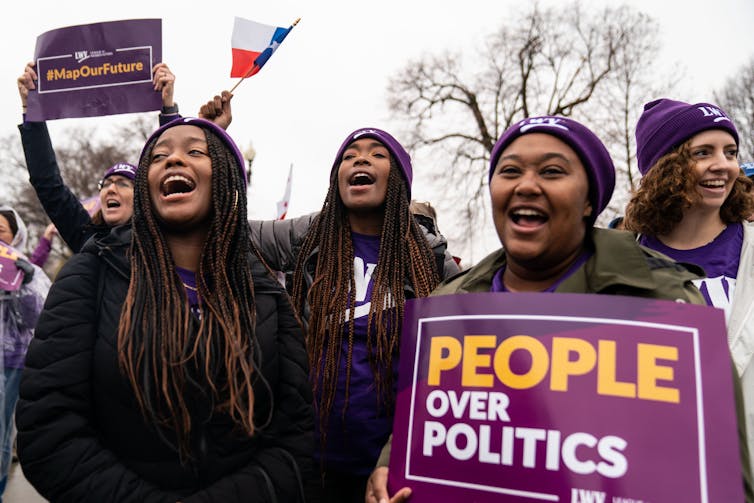Supreme Court to hear arguments in key case about gerrymandering
An upcoming Supreme Court case that turns on race and party could affect how state legislatures shape voting maps and how Americans vote for decades to come.

A South Carolina case about gerrymandering – the drawing of legislative district lines to maximize political power – that could affect voting rights around the country will be one of the cases decided by the U.S. Supreme Court during its upcoming 2023-2024 term.
The case, Alexander v. South Carolina State Conference of the NAACP, concerns the way state legislatures consider race and party when they are redrawing state voting maps.
The Supreme Court ruled in 1993 in Shaw v. Reno that racial gerrymandering – when legislatures draw district lines primarily based on race – is unconstitutional, regardless of legislators’ intent, except in rare circumstances. Voters’ party identification, however, is fair game.
At issue in the case before the Supreme Court is how the South Carolina Legislature redrew its 1st Congressional District after the 2020 census. The majority Republican lawmakers moved over 140,000 residents from the 1st Congressional District into the 6th Congressional District.
The NAACP argues the Legislature moved over 30,000 of those residents because they were Black, in violation of the equal protection clause of the Fourteenth Amendment to the U.S. Constitution. In past cases, the Supreme Court has interpreted the equal protection clause to prohibit racial gerrymandering. But the South Carolina maintains the Legislature moved the residents to ensure the district was majority-Republican and that residents’ race was not a major consideration.
In October 2021, the NAACP and a South Carolina voter challenged several of South Carolina’s new state and congressional districts in federal court. A three-judge panel ruled in January 2023 that the Legislature, despite its protestations to the contrary, had moved residents primarily based on their race. The panel gave the Legislature until March 31, 2023, to submit a new map, but extended the deadline after the state appealed the decision to the Supreme Court, which announced on May 15, 2023, that it would hear the case.
As political scientists who research legislative and judicial politics, we study gerrymandering and how legislatures use the practice to ensure political and partisan control. We believe that the court’s decision in the Alexander case will affect how legislatures handle redistricting in the future.
No clear precedent
The issue of redistricting is not an area of settled law. In the spring of 2023, the Supreme Court issued two rulings on voting rights that surprised many court observers. In Allen v. Milligan, the court required Alabama to draw an additional district with a majority Black population to ensure Black voters could elect representatives of their choice.
In Moore v. Harper, the court reaffirmed that state legislatures do not have total control over redistricting – state courts can decide redistricting cases. Had the Supreme Court ruled the other way, there would have been no court that could hear claims of partisan gerrymandering in federal elections.
The Alexander case, is like Milligan and Moore in that it involves challenges to state redistricting plans. But because the precise legal questions differ, the Milligan and Moore decisions tell us little about how the Supreme Court may rule in Alexander.

Because Alexander is about the equal protection clause, rather than, as in Milligan, the Voting Rights Act of 1965, different legal doctrines apply.
Under the Voting Rights Act, it doesn’t matter whether a legislature intended to discriminate against racial minorities. If the new districts significantly limited their voting power, it is illegal.
In equal protection clause cases, it’s not just the impact on minority voters that matters; it’s how the legislature thought about and used race when it drew districts. If the legislature used the race of voters as the predominant factor in drawing the district, then its redistricting plan, absent a compelling reason, is unconstitutional.
Many organizations celebrated the decisions by the conservative-leaning court to limit the ability of legislatures to shape elections. But state lawmakers in Alabama initially refused to comply with the Mulligan ruling. On Sept. 26, 2023, the Supreme Court ruled that Alabama must redraw the map to create a second majority Black voting district.
Supreme Court has heard gerrymandering cases before
Drawing legislative district lines to maximize political power has been around since the early days of the republic. But despite the long history of gerrymandering in the United States, there is growing evidence that American voters have become disdainful of the process.
Aside from its ruling on racial gerrymandering in the 1993 Shaw case, the Supreme Court has ruled on partisan gerrymandering as well. That’s when legislators draw district lines based on citizens’ political party affiliation. In Rucho v. Common Cause in 2019, the court ruled that partisan gerrymandering claims could not come before federal courts.
The Alexander case is significant because it turns largely on whether race or party drove the South Carolina Legislature’s map-making process, and it offers the Supreme Court the chance to clarify how a judge can make the distinction.
The challenge for the Supreme Court is that race and party significantly overlap, particularly in South Carolina. According to national exit polls, 87% of Black voters supported Democrat Joe Biden and 58% of white voters backed Republican Donald Trump in the 2020 presidential election. In fact, scholars have argued that Black voters are the most politically unified group in American politics. The race and party connection is even more pronounced in South Carolina. There, 90% of Black voters supported Biden and 73% of white voters opted for Trump.

Scholars refer to this phenomenon as conjoined polarization. The Supreme Court wrestled with this issue in 2001 in Easley v. Cromartie and again in 2016 in Cooper v. Harris. But the results in those cases only muddied the waters because they failed to specify how plaintiffs could demonstrate that legislators were motivated by racial, rather than partisan, considerations.
The Alexander case also raises the question of whether legislators can take advantage of conjoined polarization and move voters based on race to create a partisan-dominated district. In 2017, the Supreme Court said this is likely unconstitutional, but the suggestion was relegated to footnotes and rejected by conservative Justices Samuel Alito and John Roberts. Conservative Justice Clarence Thomas wrote his own opinion and newly appointed Justice Neil Gorsuch, also a conservative, did not participate. Since then, two other conservatives justices – Amy Coney Barrett and Brett Kavanaugh – have joined the court.
Conjoined polarization among American voters is likely to continue, as are attempts to maximize political advantage through redistricting. But the Alexander decision could provide a clearer path for voters to prove whether racial, rather than partisan, motivations guided legislative redistricting.
If the Supreme Court decides Alexander in line with its recent support for minority voting rights, there will be ramifications for voting rights across the nation that could reshape American democracy for decades.
The authors do not work for, consult, own shares in or receive funding from any company or organization that would benefit from this article, and have disclosed no relevant affiliations beyond their academic appointment.
Read These Next
Billionaires with $1 salaries – and other legal tax dodges the ultrawealthy use to keep their riches
The richest Americans can largely avoid paying income and other taxes. A new book explains the history.
America faced domestic fascists before and buried that history
Although thousands of Americans embraced fascist ideas during the interwar years, a new study examines…
Supreme Court case about ‘crisis pregnancy centers’ highlights debate over truthful advertising stan
There are some 2,500 of these centers across the United States. Many are located within a mile of an…






